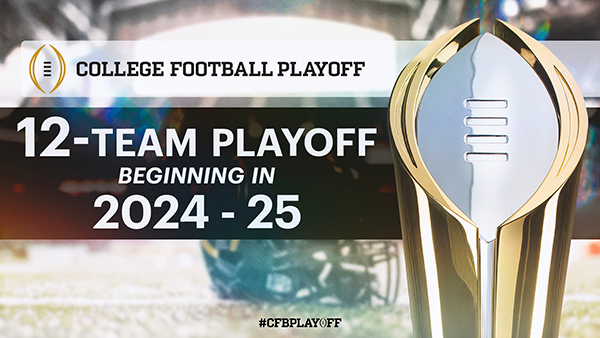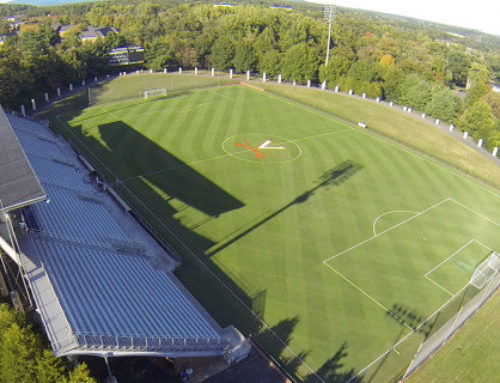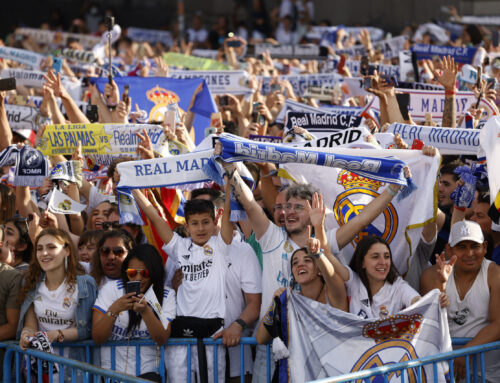We knew a 12-team playoff was coming to college football, but we found out in early December, officially, that it will begin in the 2024 season. College football will have one more year with potential high-stakes regular season games between great teams before those stakes move down the board to more middling squads post-2023.
(It’s entirely possible, pending next year’s results, that the last single regular season game that by itself changed anything about the composition of the postseason field was when Cincinnati beat Notre Dame in 2021. No, I’m not bitter about this, why do you ask?)
The model is identical to the one proposed by the original working group back in the summer of 2021, the one assembled two years prior to examine the feasibility of an expanded field. ND athletic director Jack Swarbrick was on that group, along with Mountain West commissioner Craig Thompson, SEC commissioner Greg Sankey and then-Big 12 commissioner Bob Bowlsby. You might recall expansion appeared imminent after that group’s original announcement until it was revealed that the SEC was poaching the Big 12’s two most valuable properties just weeks later, throwing the whole enterprise into chaos.
The 12-team CFP is one that, unlike all previous iterations of college football’s postseason, contain very clear pros and cons for Notre Dame, the sport’s one relevant independent now that BYU has ended its decade-long dabble with the concept in favor of the Big 12. (In fact, in 2023 the sport will be down to four independents, with only UConn, UMass and Army joining ND in remaining untethered to a football conference.)
Up until now, college football’s postseason was mostly the same for everyone: Win them all and play a schedule mostly consisting of power-conference teams, and as long as the system allows for enough unbeaten teams, you have a chance to be the champ. Any other scenario, and you’re at the whims of good fortune, as well as the polls or a committee. Now, things are changing.
Con: Notre Dame can’t get a bye
The top four seeds in the new CFP, and their accompanying byes, will be reserved for the highest-ranked conference champions in the field. The Irish can’t get one. The rationale is that Notre Dame cannot play in a conference championship game and take the accompanying “risk” (I put this in quote marks because in a 12-team CFP, most of the power teams playing in these games are going to be in the playoff win or lose; the risk will be minimal).
Personally, I’m not much for this concept. After 2025, we all know the CFP will move quarterfinals from the bowl sites, where they will be in 2024 and 2025, to campus sites. (The only reason they will be in those two seasons is because per the CFP contract, they had to play ball with the bowls to expand.) It feels like a bye and a home game is a huge advantage to give to conference champions – who in some extreme cases might be borderline top-10 teams – over teams that most observers would agree are better.
Those byes could also sometimes throw the bracket somewhat out of whack. The Athletic’s Stewart Mandel noted during the final weekend of the season that, if this year’s final rankings were applied to a 12-team playoff field, #2 seed Michigan, who had theoretically earned an easier path by beating Ohio State, would find itself looking at a much more difficult path than the Buckeyes (provided Ohio State dispatched whoever the #11 seed would be, which, safe assumption).
In this case, Michigan wins its conference and has to play “No. 7” Alabama in a quarterfinal, Ohio State doesn’t win its conference and gets to play “No. 3” Clemson.
That ain’t it.
— Stewart Mandel (@slmandel) December 4, 2022
I do understand the desire to reward conference champions, despite its implementation. I wouldn’t blow up that idea. If it were up to me, though, I would add a provision that teams can ‘steal’ a bye, but only by defeating a top-4 conference champion in a non-conference game and also ending the season ranked higher than said champion. This would allow a top-4 Notre Dame to get a bye, yes, but any non-champion would have a path to doing it, and it would in theory encourage aggressive non-conference scheduling.
Pro: A top-5 ND will have a decent path to the semifinals
The upshot to the above issue is that a top-5 Notre Dame will have as manageable a path as you could ask for to reach the semifinals. If ND hits its ceiling of a #5 seed in the new CFP, the Irish will host the weakest team in the field in the first round. This presumably would be the sixth-highest ranked conference champion most years, so you’re looking at a team on the level of Tulane this season.
Maybe just as important, that hypothetical Irish team would then face the lowest-ranked bye team, the fourth-best conference champion, in a quarterfinal. Now that the B1G and SEC have dispensed with any pretense that they’re taking over the sport, that’s likely to be merely a borderline top-10 team. This season, that team would have been Big 12 champion Kansas State, ranked #9. Until KSU upset TCU in the Big 12 title game, that team would have been Clemson, and you might recall that Notre Dame had some reason to believe it can beat the Tigers.
From there, it would be on to the semis and presumably a matchup with the top seed. That part is not ideal. But hey, this CFP is going to be like that; you’re going to have to beat at least 2, and probably 3, elite teams in a row to win. Which brings me to:
Con: It will be harder than ever to win it all
This is more of a big-picture con than one for Notre Dame specifically, but it’s something I wonder if people have fully thought through. Beating 3 elite teams in a row is something very, very few programs are capable of doing. I’d argue Notre Dame is not presently one of them (though hopefully that is changing with Marcus Freeman’s emphasis on recruiting), which, given ND has clearly been a top-10 program the past several years, sums up how difficult it is.
I think this new CFP actually shrinks the number of teams that can win it all, rather than growing the pool. Some would argue recruiting will become less top-heavy because of expansion, but early returns don’t agree: Alabama signed the #3-highest rated class of the Internet era this year, even though every player signing knew through most of their recruiting process that the CFP would be expanding during their time in school. The current On3 2024 recruiting class rankings have Georgia 1st, followed by Alabama, Florida and Ohio State. (ND is 5th.) It does not appear that top recruits were merely waiting for the playoff door to open to the unwashed masses so they could all stop congregating in Tuscaloosa (or Athens or Columbus).
Needless to say, I’m extremely skeptical that a system where teams like Alabama and Ohio State will be all but guaranteed to never miss a playoff again (one was left out in 2022, and the other would have been had USC not neglected to field a defense) will keep players from going to those schools. If anything, the transfer portal and NIL (two areas not really working in tandem to help ND at the moment) might help with parity in the long run, but I don’t think the CFP format will make a dent. The BCS produced a variety of finals every year of its existence until the Saban dynasty took over everything, and it didn’t change recruiting much, so I don’t think this will either.
The verdict: Meh
As far as Notre Dame is concerned, I don’t think the new CFP format will be a big positive or a big negative. The inability to get a bye is somewhat balanced out by creating a manageable path to the semifinals for a top-5 Irish team. However, once the system makes its anticipated change to on-campus quarterfinals for the 2026 season, the thought of a hypothetical top-5 ND having to play on the road against a team any neutral observer would agree they are superior to is pretty annoying.
And in the big picture, the format, combined with the portal and NIL being net negatives for the Irish at the moment (albeit mostly self-imposed net negatives), doesn’t create a lot of excitement that the door is open for a national championship. But I don’t think that is a much different situation than ND is already in.





Call me crazy, but I think it’s a big positive. Yes, I realize and understand a 12-team playoff makes it harder and build in less likelihood for Notre Dame to win a title.
But, to me, the first ND loss of the year as an independent basically ends all playoff hopes in the current system. Yes, they could have an outside chance with 11-1 and all the important other games break in just the right way, but overall the margin for error is very low. And certainly at a second loss, pack it in and basically forget about any meaning for the season.
Now, that changes and in a big way. A 10-2 ND team should have a really good shot of being in the playoffs. More playoff access = playing more relevant games deeper into the season = better.
It’s harder to win the ‘ship which sucks, but it’s always been difficult and proven not happening in 2 or 4 team formats. I don’t think ND will necessarily be that further away from winning a title based on the format, aside from the nature of having an extra game in the mix.
I am with you. This gives us more meaningful games.
It probably makes it at least twice as hard for us to win a NC. But that reduces our chances from like 1% to 0.5%, a trade off I am willing to take.
If Freeman does somehow turn us into a recruiting power (so far nothing suggests to me that we will have a top 5 class any time soon, unrelated to MF), that will take so long that the playoff will already have morphed.
I will say that the no bye thing is stupid. If you have a committee that ranks teams, then everything is already accounted for. The “best” team should be the 1 seed, the second “best” team the 2 seed, etc. Playing/winning/losing a conf championship is already baked in.
I think you’re understating what this does to ND’s championship odds – it goes from ~1-1.5% going into a season to <.1%. It’s really bad in that regard.
I think it will make the sport more fun overall, so just a question of how you value the tradeoff of the fun of having more playoff games and the notably increased chance of winning playoff games (which now mean less) vs. the chances of ND winning a natty going from “very very small” to “effectively zero”.
Eh, I don’t think it makes it 10-15 times harder. The only situation where this is significantly worse is when we would have been in the 4 team playoff, so we would presumably get the 5 seed. We would have better than a 10% chance against the #12 team and have a decent path to the semis as mentioned, at which point we’d have slightly worse odds than now.
Basically, I would argue we are already at effectively zero. We have no chance until we can compete with the talent of the top schools. And despite recruiting better than under BK, we are arguably headed in the wrong direction relative to talent as other schools.
This at least gives us post season things to look forward to and creates the greatest month of football possible.
Cool to correct someone else’s made up stats with your own made up stats to prove your point.
the ND fans to Ohio State thought process pipeline is crazy
Even a captain in Patterson was distraught after the Marshall game and walking off early and later talked of the challenges of keeping the team together and focused after coming to the realization that they were not going to be able to achieve any of the goals that they worked and planned all year for. That’s just reality that after a second loss in this setup, the overall goals/meaning whatever you want to call it is shot.
“I don’t think ND will necessarily be that further away from winning a title based on the format, aside from the nature of having an extra game in the mix.”
This is unduly optimistic. Just to make a semi, ND will probably have to win its ~3rd/4th and ~1st/2nd hardest games of the season in the playoff, so the odds of making a semi will be lower than in 4-team setup. Then there is the increased possibility that a team like last year’s 2-loss Alabama team will be in the semis, which means that level is going to be harder on average than the current setup.
Relatively to the current baseline, it’s pretty clearly a bad setup for ND if the primary concern is winning a natty.
No more optimistic than it is pessimistic to declare it a .1% chance of winning, as if is scientifically accurate when just pulled out of thin air.
The way to determine a champion is and always will expand. Can’t fight city hall or the times, what once was 2 went to 4 and now 12 and surely before too long more than that.
It’s an extra step and more angle/machinations are involved, which makes it tougher. But Notre Dame hasn’t won even a semi-final playoff game in a 4 team setup, so my point was more that it’s not like they’ve actually been all that close to one in the last decade either.
Similar to your idea of stealing a bye, I thought after UGA got paired against OSU that maybe the top seeds should get to pick their opponent. That may work better with 4 than 12 teams though.
I saw somewhere that MLS is experimenting with that concept of highest teams selecting their next playoff opponent, maybe at a lower level at first. That would be really spicy and fun, definitely here for that and hope it grows. Would love to see that in NBA and NHL too.
For arguments sake:
ND preserves its access to the bowls/CFPND has a better chance to make the CFP 85% of teamsAssuming P5 second place teams are the loser of their championship, ND will have played one less gameND will still recruit in at least the top 15 teamsExpansion to the Big would have made it harder to qualify for the CFPFor the 5-12 teams in the CFP except ND, advancing to the NC game would mean playing sixteen gamesI would have eliminated the twelfth game and started the championship games one week earlierThis CFP preserves the G5 teams 20% of the pieBuyers remorse? The B12 champ preserves a place in the top 4 while Texas and Oklahoma may have a harder time, assuming they are in the SEC WestWe may well see the Four Corners teams in the Pac move to the B12If the PAC and B12 (and ACC) remain the same, which is the fourth vs fifth conference team?Will the ND and USC rivalry continue?
Happy St. Patrick’s Day! Good luck to the Irish womens basketball team today
Last year in May, Notre Dame’s GAA Club wins Nationals in Gaelic football!
I feel like it would be more fair for ND to be able to be seeded 1-4 but not eligible for the bye. So they would play in the first round as a home game against the lowest seed, the 5th seeded team gets a buy, and then we pick up the next round as though we had a buy as a top 4 seed.
Another solid alternative. Once quarterfinal home games are a thing I think something ought to be done in that respect and your idea is as good as any.
From August, reminding me of the 1930s – a possible undercurrent to the formation of the new CFP. Join the B10 or else:
Big Ten should pull invitation to Notre Dame and stop playing the Irish
The problem with that idea is that the B1G has shown over and over and over again that whatever ideals they claim to be pursuing all get tossed out the window whenever the opportunity to make money is in play. As long as playing ND makes schools money, they’re not going to sign up for such a move.
And even if they did, I have a feeling SEC schools would be more than happy to step in and play ND in those spots.
Whether it turns out to be a positive hinges on if it has any impact on recruiting. Prior to the NIL rollout I posited that an expanded playoff would give kids the opportunity to play close to home if they wanted and still have access to a big stage. A 12 team playoff gives an opportunity for both TCU and KSU to make the playoff (2022) or Michigan, OSU, and MSU to all make it (2021).
If the 12 team playoff meant that TCU would keep a highly rated kid away from Alabama or MSU would keep one more high ranked recruit away from OSU because they have a legitimate shot at making the playoff that would have been good for ND, who has a more unique recruiting pitch than other blue bloods.
Now with multi-million dollar NIL deals I can’t see UNC keeping a player home when Texas A&M offers him a bag regardless of playoff access, but we’ll see.
I’ve said this before, but I’m afraid it’s proving more and more true: We needed a coach like Freeman when we hired Kelly (at the latest). I think that was probably our last legitimate chance at a title. The game has changed so much since I was in college in the Davie years, that it’s nearly unrecognizable.